Limb lengthening surgery is a procedure that gradually makes an arm or leg bone longer. This procedure treats skeletal dysplasia, bone growth issues and bone length differences.
Advertisement
Cleveland Clinic is a non-profit academic medical center. Advertising on our site helps support our mission. We do not endorse non-Cleveland Clinic products or services. Policy

Limb lengthening surgery is a procedure that can make an arm or leg bone longer. Surgeons may perform limb lengthening surgery on the:
Advertisement
Cleveland Clinic is a non-profit academic medical center. Advertising on our site helps support our mission. We do not endorse non-Cleveland Clinic products or services. Policy
Limb lengthening surgery treats discrepancies (differences) in the length of arms or legs. It can also treat some conditions that cause bone growth irregularities or shorter bone length. Your provider may recommend limb lengthening surgery if you have:
Before you undergo surgery, your provider will take X-rays of your bone and measure it. These tests help your provider determine how long the bone should be. In most cases, you can expect your bone to grow up to 2 inches per surgery.
Your surgical team will tell you how to prepare for surgery. Ask your provider:
The day of your surgery, your provider will give you general anesthesia, which puts you to sleep and prevents you from feeling pain. Most people stay in the hospital for about three days after surgery. Then, you’ll need a friend or family member to take you home.
Advertisement
Before your procedure, arrange for someone to stay with you for several weeks after surgery. Most people need assistance with everyday tasks like getting dressed, preparing meals and using the bathroom. If you’re lengthening a leg bone, you won’t be able to walk on it right away. You may use a wheelchair, crutches or other aids.
Limb lengthening surgery involves two main steps. Your surgeon:
Your limb lengthening device will be one of two options:
You recover in the hospital for several days. Before you leave the hospital, your provider gives you instructions on how to use your limb lengthening device.
If you have an external device, you must clean the pin sites every day to avoid infections. If you have an internal device, keep your surgical incisions clean until they heal.
If you’re lengthening a leg bone, you won’t be able to walk for several weeks. You may use a wheelchair, crutches or other aids. If you’re lengthening an arm, you won’t be able to lift things for a few weeks.
After you heal from surgery, you enter the bone distraction phase. This phase lasts about two months. It’s when the two bone segments begin to distract (pull apart). As the bones separate, your body creates new bone to fill the gap between the two segments. During this phase, you:
Advertisement
After your bone has reached the desired length, it needs time to harden. Providers call this phase consolidation and it can last up to three months. During consolidation, you:
In most cases, you wear the device for three months per inch of bone growth. For 2 inches of bone growth, you would wear the device for about six months. After your new bone is fully hardened, your provider removes the limb lengthening device with a minor surgical procedure. Some people also wear a cast or brace for several weeks after removing the device.
You may have some pain after surgery when the anesthesia wears off. Your provider can give you pain relief.
You may also experience some pain or soreness during the distraction phase. Many people use over-the-counter (OTC) pain relievers to manage discomfort. Ask your provider which medications are safe for you.
Advertisement
Limb lengthening surgery can make bones longer in people who have bone discrepancies, bone growth abnormalities or shorter bones due to skeletal dysplasia. The procedure has high success rates with positive outcomes. Having limbs the proper length can improve your:
Possible risks and complications include:
The initial recovery in the hospital takes about three days. Full recovery from limb lengthening takes several months. During this time, you will gradually do more activity and gain more strength.
These steps will help you have a successful recovery and the best possible outcome:
Advertisement
See your provider if you notice:
Limb lengthening surgery can be life-changing for people who have bone discrepancies or bone growth conditions. Newer internal devices can make your limb lengthening process easier and safer than ever before. The success rate of this surgery is high if you work with a skilled provider and follow your post-surgery instructions. Most people live full, active lives with their lengthened arm or leg.
From sudden injuries to chronic conditions, Cleveland Clinic’s orthopaedic providers can guide you through testing, treatment and beyond.

Last reviewed on 10/14/2022.
Learn more about the Health Library and our editorial process.